Catalogue > List by artist
Browse the entire list of Rencontre Internationales artists since 2004. Use the alphabetical filter to refine your search. update in progress
Horst Baur
Catalogue : 2007Heroes | Experimental video | dv | color | 4:45 | Germany | 2006

Horst Baur
Heroes
Experimental video | dv | color | 4:45 | Germany | 2006
30 years after the end of the great proletarian Cultural Revolution, Chinese people from Munich, Germany, as well as those from Changsha, China, were asked to pose with the Maoist bible, as had been done during the revolution. There were friends, students, artists, and passers-by (China). They were free to choose a Maoist bible from among 40 different editions in which the official photo had been replaced with an image of Mao drawn by an Occidental artist. The artists included Andy Warhol, Gerhard Richter, KP Brehmer, Jörg Immendorff ...
Horst Baur was born in Munich, Germany, in 1954. From 1973-80 he studied philosophy and Catholic theology. From 1978-93 he collaborated on the avant-garde theater scene in Munich. He followed studies in editing from 1980-82, and in 1982-82 he was also co-editor of the journal "Fliegenpilz". Since 1987 he has worked on videos and performances, and since 2000, mail art.
Catherine Bay
Catalogue : 2013Blanche Neige épisode 2 | Video | hdv | color | 5:52 | France | 2012
Catherine Bay
Blanche Neige épisode 2
Video | hdv | color | 5:52 | France | 2012
Depuis 2002, le projet Blanche-Neige évolue à travers une série d?interventions : performances, conférences, spectacles et manifestations. Ici, Blanche-Neige investit l?espace filmique. Parés d?un costume et d?une perruque en latex prémoulées, designées par Roël Stassart, les interprètes battent la campagne en escadrons dans une mise en scène reprenant les codes du western et du film de guerre. L?utilisation du format Cinémascope et du grand angle permet d?aborder la place du corps dominé par les grands espaces, et renvoie la figure de Blanche Neige à l?immensité du paysage. Le personnage de Blanche-Neige, démultiplié et décontextualisé, fait se télescoper des sensations liées à la féérie enfantine et au cauchemar publicitaire. « Dans ce travail, explique Catherine Baÿ, il est question de réactiver un possible imaginaire autour d?une figure hypermédiatisée devenue objet de consommation courante et de proposer un spectacle populaire. » Ce travail sur la déformation du mythe donne lieu à un film hybride interrogeant le rapport entre industrie de l?image et imaginaire collectif.
Après des études de théâtre (École Jacques Lecoq, Philippe Gaulier, Antoine Vitez), d`ethnologie (Jean Rouch) et de danse (notamment avec Marcia Barcello, Philippe Decouflé, Milly Nichols), elle développe, depuis une dizaine d`années son travail de chorégraphe et de metteur en scène. Son parcours la conduit à se promener à travers les formes (chorégraphie, performances, mise en scène, vidéos, cabaret) et à collaborer avec des artistes de différents champs d`expression. De 1987 à 1994, C. B. orchestre des performances et des événements dans différents types d`espace : piscines, boîtes de nuit, friches industrielles et les galeries Yvon Lambert , Anne de Villepoix, .. Elle collabore notamment avec les plasticiens Combas, Jean-Charles Blais, Sylvia Bossu, les architectes Laurence Bourgeois et Pascale Lecoq, les acteurs-danseurs Alain Rigout, Amy Garmon et Laurence Levasseur. Depuis 1994, elle développe un travail spécifique sur les codes de représentation. Elle dissèque les écarts entre le corps intime et le corps social dans Relief ou le discours sur l`éloquence en portant un regard critique sur les postures des hommes politiques lors des élections de 1995. Ainsi parlait Eliane et Lulu, qu`elle élabore avec Marco Berrettini et Kolatch, joue sur la confrontation scénique de corps singuliers. En 1999, elle chorégraphie Nains mode d`emploi, spectacle qui se déroule en vitrine. C. B. y élabore un dispositif scénique complexe qui instaure un dialogue entre un écran vidéo et des acteurs. Le motif du bouffon y est exacerbé et concentre l`approche satyrique du monde de la chorégraphe. Elle travaille actuellement à la création de nouvelles interventions de "Blanche-Neige" et une création en cours " Jack in the box ". Aujourd`hui s?est renforcé par l?expérience acquise avec le projet Blanche-Neige une méthode spécifique à celle du travail avec le "Performer". Elle a donc mis au point la méthode A235. Cette méthode se développe sous forme de workshop. Le premier s` est déroulé en juillet 2009 à Micadanse (Paris) et se poursuivra à la fondation Gilbert Brownstone (Paris) courant 2010. Parallèlement à ses créations, Catherine Baÿ dirige artistiquement et coproduit différentes structures qui ont pris domicile dans ses bureaux du 41 rue du Faubourg Saint-Martin à Paris. Qu`il s`agisse du Cabaret "Nue & Habillé? de 1994, de la vitrine ?Window? crée avec les frères Stassart en 1999, de la galerie ?The Window 41? dirigée actuellement par Charlotte Batifol et Yann Perol, ou du Laboratoire A235, chacune de ses structures sont de véritable plates-formes d`échanges et de création. Elles ont permis et permettent encore de créer des événements en marge des institutions classiques et de s`interroger sur le dynamisme possible entre la production, la diffusion et la création.
Catalogue : 2007Blanche Neige épisode 1 | Experimental video | dv | color | 10:0 | France | 2006
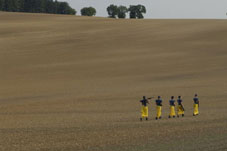
Catherine Bay
Blanche Neige épisode 1
Experimental video | dv | color | 10:0 | France | 2006
"Blanche Neige Episode #1" is the first video realization independant of the "Blanche Neige" (Snow White) series. Several Snow Whites cross a landscape and the frame of the image. The "Blanche Neige" project was initiated in Paris in November 2002, and evolved into interventions and videos. The Snow Whites, through performances, conferences, and demonstrations multiply throughout the world. Snow White, a character from another world, sneaks into our own like a virus, invades a space, adapts it to its needs, and quickly leaves it. Snow White can be seen in a multitude of different spaces and situations, in the city or in the country, in an art gallery, on a boat, alone, in a group. Snow White is never exactly the same, but never totally different either. In this project, Catherine Bay interrogates our relation to the image. The project was presented in Paris, at the Brownstone Foundation and at the Cartier Foundation; in Milan at the Uovo Festival; in Moscow at the Kliazma Festival; in Rome during the Nuit Blanche; in Lausanne at the Arsenic Theatre; in Beaubourg at Vidéodanse; and at the Parc de la Villette. Les Rencontres Internationales Paris/Berlin have invited Catharine Bay to Podewil in Berlin and the Grande Halle de la Villette. The next intervention of the Snow Whites will be held at the Mac/val Museum on September 16, 2007.
Laura Bazalgette
Catalogue : 2013INTÉRIEUR | Video | hdv | color | 6:58 | France | 2011
Laura Bazalgette
INTÉRIEUR
Video | hdv | color | 6:58 | France | 2011
Un village bordé d?un fleuve. Deux hommes, « le Vieillard » et « l?Étranger », marchent le long de la berge, dans l?obscurité. Ils se suivent et ne se connaissent pas. Flotte dans l?eau le corps d?une jeune fille. Morte. Noyée. Ensemble ils la découvrent. Il va maintenant falloir annoncer (énoncer) le drame. Attente. Dans la maison de la « petite morte » que les deux hommes observent depuis le jardin, se trouvent le père, la mère, les deux filles et l?enfant. Au coin du feu. Apaisés et doux. Ils ne savent pas. Le « Vieillard » et « l?Étranger », sont inquiets, agités. Ils tentent de retracer l?événement, de mettre en mot l?indicible terreur qui les saisit. Silence. « Le Vieillard » s?avance vers la demeure. Il frappe à la porte. Le père lui ouvre la porte. Il entre. Il le dit. NOTE D?INTENTIONS « Le poète dramatique est obligé de faire descendre dans la vie réelle, dans la vie de tous les jours, l?idée qu`il se fait de l?inconnu. Il faut qu?il nous montre de quelle façon, sous quelle forme, dans quelles conditions, d?après quelles lois, à quelle fin agissent sur notre destinée les puissances supérieures, les influences inintelligibles, les principes infinis, dont, en tant que poète, il est persuadé que l?univers est plein. » ? Maeterlinck « Le tournage s?est principalement déroulé en appartement, dans un espace de quatre mètres, sur trois. Un film en habitat avec une caméra vidéo. Il m?a semblé passionnant de mettre en frottement le lieu intime, la maison, le foyer, et la zone fictive du projet de film. Un terrain organique, apprivoisé, transformable. Les possibilités sont multipliées. Face à la problématique très concrète d?être au plus proche de mes moyens et d?y adapter le projet, il s?agissait pour moi d?inventer une autre manière d?agir. J?ai ainsi souhaité travailler avec un seul acteur qui incarnerait tous les personnages de la fiction, et par là, questionner l?artifice et le vraisemblable. Permettre le glissement du vrai au faux. J?ai donc choisi de travailler plastiquement le visage de l?acteur, de le traficoter légèrement. Créer des looks radicaux, francs et universels. Des types. Trouver le vêtement, la matière signifiante. Transformer les apparences et les identités. D?emblée comme un aveu de tricherie. De cette modification du réel, surgit un fort sentiment d?étrangeté. Il s?agit pour moi de rejoindre entièrement la FICTION DRAMATIQUE et de toucher au mystère. Un studio de cinéma fait main. Un chantier cinématographique, avec ses effets spéciaux et son montage. Expérimenter le glissement de la littérature au cinéma. Adapter. » Laura Bazalgette
Après une formation au Conservatoire National de Région de Bordeaux (2001-2003), Laura Bazalgette intègre l?École Florent en 2003 où elle travaille avec Sandrine Lanno. En 2005, elle poursuit sa formation à l?Atelier Théâtral de Création dirigé par Stéphane Auvray-Nauroy. De 2005 à 2007 elle assiste Sandrine Lanno, Bruno Blairet et Cyril Anrep au sein de L?Ecole Florent. Elle participe également à plusieurs stages de formations avec Michel Fau, Jean-Michel Rabeux, Robert Cantarella, Katell Djian, Frédéric Fisbach, Frédéric Maragnani, Renaud Cojo, Jan Fabre. Depuis Janvier 2007, elle développe un travail axé sur les écritures contemporaines. Elle met en scène Outrage au public de Peter Handke (2005), Le Fils de Jon Fosse (2007) et réalise le film L?Exercice de la raison d?après le texte de Jean-Luc Lagarce (2008). En février 2010, suite à une résidence au Centquatre (Paris), elle crée le spectacle Atteintes à sa vie de Martin Crimp . En juin 2011, elle réalise le film Intérieur, d?après le texte de Maurice Maeterlinck, 1er film du projet All By Myshelves (adaptation cinématographique d??uvres littéraires). Elle réalise de nombreux assistanats : auprès de Frédéric Maragnani et la compagnie Travaux Publics (Plage, Baroufs) et auprès de Christophe Huysman pour le spectacle L?Orchestre perdu. Elle est actuellement en répétitions sur sa prochaine création théâtrale qui s?intitule « Séries » et qui se jouera en février 2013.
Magnus Bärtås
Catalogue : 2015Miraklet i Tensta (Theoria) | Experimental doc. | hdv | color | 16:36 | Sweden | 2014
Magnus BÄrtÅs
Miraklet i Tensta (Theoria)
Experimental doc. | hdv | color | 16:36 | Sweden | 2014
Theoria is the Greek word for talking about something witnessed. If, during ancient times, someone during a travel experienced an extraordinary event a theoria was performed when the witness returned home. Philosophers talked in terms of "ritualized visuality" that received a political significance where the person lived, and the important part of a theoria was the social situation when the witness shared his experiences. The theoria that is dealt with in the film is based on the events that took place in a suburb of Stockholm, Tensta, in August 2012. A young girl borrowed her mother’s smartphone and took a photograph of a peculiar cloud in the sky. The image, that started to circulate on social media, was interpreted as an apparition of the Virgin Mary by many residents of Tensta. Thousands of people gathered in the local Syrian Orthodox church and again the miracle was witnessed, both in the condensation in the windows and in the trees outside the church. The story of the miracle in Tensta disappeared very quickly from mainstream media, but lived on different online discussion sites. In the film seven local residents perform a whispering reading of a manuscript written from these online discussions. The reading is combined with documentary footages from the church. The textual quality is emphasized and contrasted to the ecstatic situation and the documentary images where viewer has to ask her self what she is really seeing.
Magnus Bärtås is an artist, writer and professor of fine arts at Konstfack in Stockholm working with text, video, objects and installation. His dissertation in artist research, You Told Me – Work stories and video essays, was published in May 2010. Together with Fredrik Ekman he has published three books of essays. Their latest book, Alla monster måste dö (“All monsters must die”), was nominated to the Swedish national August prize. In 2010 his video essay Madame & Little Boy won the grand prize at Oberhausen International Short Film Festival. Recent exhibitions include “The Miracle in Tensta”, Tensta Konsthall, The 9th Gwangju Biennale 2012, and “ABCDEFGHI” at Marabouparken, Stockholm, 2013.
Catalogue : 2010Madame & Little Boy | Experimental doc. | | color | 28:0 | Sweden | 2009

Magnus BÄrtÅs
Madame & Little Boy
Experimental doc. | | color | 28:0 | Sweden | 2009
In 1978 the legendary South Korean actress Choi Eun-Hee was kidnapped in Hong Kong by North Korean agents and brought to Pyongyang. Two weeks later her ex-husband, the director Shin Sang-Ok, was abducted to North Korea as well. After spending five years in the country the couple was offered a ?contract? which included a public statement declaring their willful defection to North Korea, a major film budget, enormous resources in terms of equipment and extras, and furthermore a re-marriage. Two years later the artist-pair managed to escape, after having directing and producing a number of films in North Korea, eventually taking political asylum in the United States. Not yet finished was Pulgasari (1985), a Japanese-style monsterfilm based on a Korean legend and made in the vein of Godzilla. Madame & Little Boy is a video essay where historical lines and the circles of repetition in the life story of Choi Eun-Hee (Madame Choi) are examined. The genealogy of the monsters from Godzilla, via Pulgasari to Galgameth (Shin?s remake of Pulgasari in Hollywood) is interpreted as deliberate messages about atomic weapons.
As an experiment with situated narration this video essay takes a standpoint against documentarism and common documentary practice. The story of Madame and Little Boy (the code name of the Hiroshima bomb) is narrated by the American musician Will Oldham (aka Bonnie ?Prince? Billy) in a studio building next to The Nike Missile Site outside San Francisco. The studio building becomes place for viewing and talking back to images: the surrounding American landscape, the missile site (?a petrified monster?) where atomic weapons were kept in secrecy, clips from Shin Sang-ok?s production together with footages from North Korea. This site, serving as an intersection of the present and past, is also the meeting place with the gaze of Choi Eun-hee, filmed in a hotel in Seoul.
Magnus Bärtås, Behzad Khosravi Noori
Catalogue : 2025On Hospitality – Layla Al Attar and Hotel Al Rasheed | Experimental doc. | digital | color | 18:0 | Sweden | 2024
Magnus Bärtås, Behzad Khosravi Noori
On Hospitality – Layla Al Attar and Hotel Al Rasheed
Experimental doc. | digital | color | 18:0 | Sweden | 2024
On Hospitality is a necromantic documentary where the Iraqi artist Layla Al-Attar returns from the dead to tell the story of how a Swedish company built a luxurious hotel in Baghdad, ordered by Saddam Hussein for the 1983 summit of the Non-Alignment Movement. War changed all the plans. Layla made a mosaic at the entrance of the hotel, depicting George Bush’s face, and her house was hit by an American missile.
Magnus Bärtås is an artist, writer and filmmaker, and has exhibited at Gwangju Biennial, Göteborgs Konsthall and Moderna Museet, Stockhom among other venues. He won the grand prize at Oberhausen International Short Film Festival in 2010 with Madame & Little Boy. Behzad Khosravi Noori is an artist, writer and filmmaker working between Karachi and Stockholm. Bärtås and Khosravi-Noori won the 1st Prize of the Jury of the Ministry of Culture and Science of North Rhine-Westphalia at Oberhausen International Short Film Festival with On Hospitality – Layla al Attar and Hotel al Rasheed in 2024.
Denis-paul Beaubois
Catalogue : 2007Terminal Vision Project 2, The Fall From Raiatea | Video | dv | color | 4:0 | Australia | 2006

Denis-paul Beaubois
Terminal Vision Project 2, The Fall From Raiatea
Video | dv | color | 4:0 | Australia | 2006
The fall from Raiatea focuses on the act of falling. The cameras are released, as opposed to thrown, from the 29th floor of one of the Waterloo towers in Sydney. Its own weight drags it towards the ground. As it falls it echoes the collapse of grand ideals. In this case the fall of modernism and mass democratized housing. The fall as a release (as opposed to an act of misadventure) was an important aspect in the creation of this work. There is an optimism and an allure of freedom which comes with surrendering oneself to forces outside our control. Once power surges through the cameras circuitry, the act of experiencing (as opposed to recording) begins. The camera reacts to its surroundings and continues to do so until it is eventually destroyed. Its multiple viewpoint is designed to eradicate the singular point of view that suggests the experience of one person. With five cameras simultaneously recollecting the same fall, the viewer is the only point of stillness in the equation. It is the world around us falling as we remain still.
Denis-Paul Beaubois was born in Mauritius in 1970 and currently resides in Sydney, Australia. Denis has worked as a video and performance artist in Australia and internationally for the past 11 years. His works have been screened/performed in festivals and galleries in Europe, USA, South America, Asia and Australia, most notably winning the 1998 Bonn Videonale in Germany, and receiving the Special Award for the Mediunkunst preis 2001 at ZKM, also in Germany. Recently his work has been exhibited at SCAPE 2006 Biennial of Art in Public Space in Christchurch, New Zealand and at Glass Kulture Koldo Mitxelena in San Sebastian, Spain.
Catalogue : 2006Terminal Image1- The fall from Matavai | Video | dv | color | 1:30 | Australia | 2004

Denis-paul Beaubois
Terminal Image1- The fall from Matavai
Video | dv | color | 1:30 | Australia | 2004
In the Fall from Matavai, the action of falling (physically and symbolically) is explored. The work is seen as a release to forces outside our control. Each step, tainted by the passing of history, reflects oppositional forces against a dominant vision. The fall from Matavai explores the remnants of past hopes, and their grand ideals, which have long since been discredited by history. The fall, in this case, is the collapse of modernism, the dream of mass democratised housing gone wrong. The work also explores the recorded image as ?Terminal Vision? where physical event is destroyed in order to consolidate itself with the process of recording.
Born in Mauritius 1970 Has worked as video and performance artist in Australia and internationally for the past 11 years. He is a member of performance ensemble GravityFeed and has worked with. the Post Arrivalists and Gekidan Kaitaisha. His works have been screened / performed internationally in festivals and galleries such as; 1997: The Cleveland Festival of Performance Art as a featured Artist (USA). 1998: Bonn Videonale, (Germany) where he was awarded first prize. EMAF (Germany). Fimform (Germany). Dokumentar festival (Germany).1999: Arco Electronico (Spain). Artist Unlimited eV Bielefeld (Germany). 2000: Darklight film festival (Ireland). Canberra Contemporary Artspace (AUST). Center For Contemporary Photography, Melbourne (AUS). Linden Arts Center, Victoria (AUST). 2001: ZKM, received Special award for the Mediunkunst preis 2001 (Germany). 2002: Kunsthaus Zurich. 2003: Museum Ludwig Koeln (Germany). 2004: Transmediale (Germany). D Art04 Sydney Film Festival. (AUST).2005: Adelaide Film Festival (Aust), ParaSite Art Space (Hong-Kong).
Catalogue : 2006Hope # 1 | Art vidéo | dv | color and b&w | 36:39 | Australia | 0
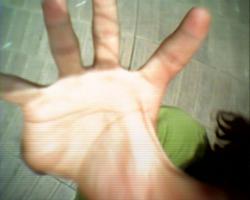
Denis-paul Beaubois
Hope # 1
Art vidéo | dv | color and b&w | 36:39 | Australia | 0
The camera is treated as a ?life form? as opposed to a tool which selectively gathers information. When activated it records its environment and continues to do so until destroyed. The transmitted image reacts to the physicality of the event resulting in a broken signal, which intermittently interrupts the image. As the throws become more vigorous and greater damage is sustained by the camera, the interruption to the image becomes more pronounced. Hope#1 is part of a series of works which explore the politics of the recorded image through physicality and destruction. It questions current representations of a sterile screen based reality which monopolises the airwaves. The work makes use of transmission and reception technology to explore the dissemination of information as power. A model is suggested, which parallels inclusion within the reception area with existence. Access to information delineates a border between the informed and the uninformed. Those who fall outside the range of reception are marginalised and perhaps do not exist. The broken, intermittent signal, transmitted by the units, is akin to ?being at the edge of existence?. The intermittent signal fosters uncertainty by revealing snippets of facts, partial information. The dictum of ?ignorance being bliss? is not possible when one locates oneself on the boundary. The intermittent signal is a tool of potential panic or misinformation. The receiver is aware of part of the information and it is the uncertainty created through this structure which leads to disruption. ?To be at the edge of existence? is to locate oneself at the junction between information and oblivion. The work attempts to locate the physical extremity of a signal and by doing so delineates a boundary between inclusion and exclusion. Within this model the question of ?who is placed in the marginalised position?? is raised. Is it the ?transmitter? who is robbed of a voice, or is it the potential receiver who falls outside of the signal range (or does not possess the means to harness the signal), and thereby is excluded from information? To be at the edge of existence is to be subjected to the interrupted / intermittent signal. Who or what determines the boundary? Physically the boundary of the signal is related to power. Metaphorically the boundary is race, class, gender and political belief. Hope # 1 occurred outside of the Australian High Court in Canberra, the final / Terminal place of Judgement in the Australian Judicial system.
Born in Mauritius 1970 Has worked as video and performance artist in Australia and internationally for the past 11 years. He is a member of performance ensemble GravityFeed and has worked with. the Post Arrivalists and Gekidan Kaitaisha. His works have been screened / performed internationally in festivals and galleries such as; 1997: The Cleveland Festival of Performance Art as a featured Artist (USA). 1998: Bonn Videonale, (Germany) where he was awarded first prize. EMAF (Germany). Fimform (Germany). Dokumentar festival (Germany).1999: Arco Electronico (Spain). Artist Unlimited eV Bielefeld (Germany). 2000: Darklight film festival (Ireland). Canberra Contemporary Artspace (AUST). Center For Contemporary Photography, Melbourne (AUS). Linden Arts Center, Victoria (AUST). 2001: ZKM, received Special award for the Mediunkunst preis 2001 (Germany). 2002: Kunsthaus Zurich. 2003: Museum Ludwig Koeln (Germany). 2004: Transmediale (Germany). D Art04 Sydney Film Festival. (AUST).2005: Adelaide Film Festival (Aust), ParaSite Art Space (Hong-Kong).
Christophe Beaucourt
Catalogue : 2007Slowsand in inaccuracies of the mind machine | Animation | dv | color | 1:40 | France | 2005
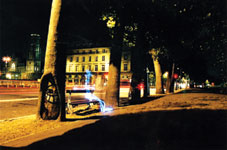
Christophe Beaucourt
Slowsand in inaccuracies of the mind machine
Animation | dv | color | 1:40 | France | 2005
In their urban solitude, blue luminous characters come to temporize the night.
Christophe Beaucourt has been created fixed and animated images since 1997, the year in which he started to work as a cameraman for snowboarding videos and as a photographer in the press (snowboard, skateboard, bmx). In parallel with his activities as a television cameraman/editor, he has been working on road art since 2001, first at "Graff it!" as a photographer and journalist, then as a collaborator for two years with the agency "sipa". He has taken part in works such as "stencil project" and "graffiti urban wallpaper". He has also directed experimental documentaries on road art which have been selected at various festivals.
Martin Beauregard
Catalogue : 2018Another Day after Eternity | Video installation | 4k | color | 8:38 | Canada | 2017
Martin Beauregard
Another Day after Eternity
Video installation | 4k | color | 8:38 | Canada | 2017
L'oeuvre rend visible une forme de résurgences de l'expèrience traumatique au sein de la création d'environnements 3D représentatifs de la vie domestique. Sans jamais montrer l'horreur des évènements, elle participe de processus de recontextualisation et réinterprétation d'archives web d'attentats terroristes, ceux survenus notamment à Paris (2016), Bruxelles (2016) et Istambul (2017). Elle engage l'expression d'une temporalité humaine écartelée entre la réalité de l'événement et sa médiation faisant signe quelque part entre la vie, le son et l'image.
Martin Beauregard est artiste professionnel et professeur-chercheur-créateur à l’Université du Québec en Abitibi-Témiscamingue. Martin Beauregard est diplémé de l’Université du Québec à Montréal (PhD en études et pratiques des arts) et de l’Université Paris 1 Panthéon Sorbonne (PhD en arts plastiques et musicologie), ainsi que de l’école des Beaux-arts de Bordeaux (Master en arts et médias). Son travail artistique a été présenté dans de nombreuses institutions, notamment au Musée des beaux-arts de Montréal (Montréal, Canada), Location One (New York, Etats-Unis), au Capc Musée d’art contemporain de Bordeaux (Bordeaux, France) et à l’Asahi Art Square (Tokyo, Japon).
Yann Beauvais
Catalogue : 2011meeting paul in buffalo | Experimental film | dv | color | 3:10 | France | 2010
Yann Beauvais
meeting paul in buffalo
Experimental film | dv | color | 3:10 | France | 2010
Une brève visite à Buffalo à l`occasion d`une projection de mes films invité par Paul Sharits. Quelques fragments initialement tournés en super 8 dans les années 80
Yann Beauvais est né en 1953, il vit et travaille à Paris et São Paulo. Il est cinéaste, critique et curateur. Il est l'auteur d'une trentaine de films courts et d'installations. Il est cofondateur de Light Cone, structure dédiée à la diffusion et la sauvegarde du cinéma expérimental qui est aujourd'hui, avec plus de 3500 films à son catalogue, la plus importante coopérative européenne de diffusion du cinéma expérimental. Il a enseigné l'esthétique et l'histoire du cinéma expérimental au Studio Le Fresnoy, à l'Université Paris 3 - Sorbonne Nouvelle et à l'Université de Floride. Il a été conservateur et programmateur à l'American Center et est intervenu au Centre Pompidou, au Musée d'art moderne de la Ville de Paris ainsi qu'au Musée du Jeu de Paume. Ses articles, publiés dans diverses revues, ont été rassemblées dans le recueil "Poussière d?image, paru en 1998, aux Éditions Paris expérimental.
Sarah Beddington
Catalogue : 2011Lost in Space | Art vidéo | 0 | color | 5:55 | United Kingdom | 2009
Sarah Beddington
Lost in Space
Art vidéo | 0 | color | 5:55 | United Kingdom | 2009
`Lost in Space`, 2009, 16mm film in colour, 5:55 min, with sound `Lost in Space` was filmed at an abandoned U.S. nuclear missile base and is part of Beddington?s investigation into capsular architecture of the Cold War period. The strange flying saucer-like object, lying abandoned on an old baseball court, was part of a now defunct radar system used to pinpoint co-ordinates for a nuclear-charged missile launch during the 1960s. In the film the object is approached cautiously thus giving it a certain presence that is heightened by shots of moving clouds and swaying vegetation. Sarah Beddington makes films that often investigate environments from the past as a starting point from which to look at the present. With `Lost in Space`, as in all of her other work, there is a sense of anticipation of waiting for something to happen. The meticulously observed compositions of her shots from an unmoving camera encourage the viewer to slow down and observe details of stillness and watching, light and shadow that turn this object of surveillance, once part of a system of power and fear, into an abject one that is now being surveyed. This relic from a utopian future that never happened becomes a surreal sundial for another era.
Sarah Beddington is a British artist and filmmaker, currently based in Paris, whose work is documentary in nature and investigates the intersection between the social, the personal and the political. Working in a variety of media, she records unique social and aesthetic circumstances that can manifest themselves in unanticipated ways. Her work revolves around the juxtaposition of the historical and the contemporary, often in relation to specific places, journeys and migration. Whether using installation, film or video, Beddington constructs parallel moments which, existing within a non-linear, non-narrative time, often have a dream-like quality. Solo exhibitions include Places of Laughter and of Crying, Bloomberg SPACE, London (2008); Crossing, DAC, New York (2008); Panoptiscope, Petrie Museum of Egyptian Archaeology, UCL, London (2006); Parallel Lines and Other Stories, Artlab, Berlin (2005). Group exhibitions include Liverpool Biennale: Future Movements (2010); Les Rencontres Internationales, Reina Sofia Museum, Madrid (2009); Eastern Standards: Western Artists in China, MASS MoCA (2009); Vanishing Point, Wexner Center for the Arts, Columbus, Ohio; About Time, Nordjyllands Kunstmuseum, Denmark. Her work is represented in a number of public and private collections including Arts Council England.
Catalogue : 2009Brief Encounter | Video installation | dv | color | 2:46 | United Kingdom, USA | 2007

Sarah Beddington
Brief Encounter
Video installation | dv | color | 2:46 | United Kingdom, USA | 2007
`Brief Encounter` (2006), TRT 2:50 min, three-channel PAL digital video, no audio `Brief Encounter` uses three simultaneous images to reflect on the fragility of current life in Lebanon. The central image was filmed in West Beirut. A couple is seen at a café table beyond a divide created by a dirty piece of plastic sheeting. The man is dressed in army uniform, the woman?s head is covered with a hijab. They face one another, talk and laugh, move ever closer and finally briefly hold hands. The left hand image shows a tethered hot air balloon slowly rising slowly until it can go no further, into a post-sunset sky beyond the Holiday Inn in Beirut. This high-rise building, close to the Mediterranean, still shows the scars of mortar fire from the civil war that ended in 1990. The right hand image shows a cedar tree, the motif of Lebanon that is present on the flag. In this shot the tree is a symbolically immature specimen, intermittently shrouded in a mist that undermines its materiality.
Sarah Beddington is a British artist based in London and New York whose multi-disciplinary work examines the intersection between the personal, the political and the social to be found at the periphery. None of her film and video works are staged, they are non-narrative observations, verging on the documentary, recorded from an unmoving camera. The works are characterised by meticulous framing, sensuous imagery and suspense reminiscent of film noir - a sensibility informed by her practise as a painter. Under her detached gaze, cultural and visual fragments coalesce into poetic tableaux. With seemingly disconnected sequences, Beddington builds an eloquent insight into a world that appears to run parallel to our everyday understanding of it. Solo exhibitions include ?Crossing?, DAC, New York (2008); `Places of Laughter and of Crying`, Bloomberg SPACE, London (2008); `Panoptiscope`, Petrie Museum, UCL, London (2006); `Parallel Lines and Other Stories`, Artlab, Berlin (2005). Group exhibitions include `Eastern Standards: Western Artists in China`, MASS MoCA (until March 2009); `Vanishing Point`, Wexner Center for the Arts, Columbus, Ohio; `About Time`, Nordjyllands Kunstmuseum, Denmark; `Panoramica`, The Rufino Tamayo Museum, Mexico City. Her work is represented in a number of public and private collections including Arts Council England.
Roger Beebe
Catalogue : 2008TB TX DANCE | Experimental film | 16mm | black and white | 2:30 | USA | 2006
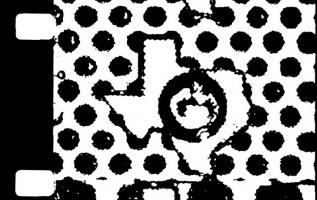
Roger Beebe
TB TX DANCE
Experimental film | 16mm | black and white | 2:30 | USA | 2006
The background of the image is made of patterns of dots directly laser printed on clear leader. That background also doubles as an optical soundtrack with different pitches created by the different density of dots. The dots were inspired by the stockings Toni Basil (?Antonia Christina Basilotta?) wore in Bruce Conner?s ?Breakaway? in 1966, which also serves as the source footage for the dancer in the film. Toni Basil herself is a source of inspiration for all 30-somethings who haven?t yet made enough of their lives. (She was 39 when ?Mickey? was a hit in 1982.) This film was commissioned at Cinematexas in 2005 over a meal of pulled pork and peach cobbler. This film is also known as ?32.37? (the price of that meal). From the Lunchfilm series: curator Mike Plante has lunch with a filmmaker and then gets a film for the cost of the lunch in trade. Some rules are written on a napkin. Here are the rules for this commission: Reference dance. Reference Texas. Have an autograph in it. Mention Toni Basil.
Roger Beebe is a professor of film and media studies at the University of Florida. His work has been shown around the globe at such unlikely venues as McMurdo Station in Antarctica and the CBS Jumbotron in Times Square and at more likely ones including the Museum of Modern Art, Ann Arbor, NY Underground, and Rotterdam. From 1997-2000 he ran Flicker, a bi-monthly festival of small gauge film in Chapel Hill, NC, and he is currently artistic director of FLEX, the Florida Experimental Film/Video Festival.
Catalogue : 2007S A V E | Experimental film | 16mm | color and b&w | 5:0 | USA | 2006

Roger Beebe
S A V E
Experimental film | 16mm | color and b&w | 5:0 | USA | 2006
A disused gas station offers a curious imperative: "Save". A riddle posed in the form of architecture: what is there to save? One more instalment in the history of Americans pointing their cameras at gas stations; an attempt to figure out something about where we've been, where we're headed, and what's been left behind. The first part of "S A V E" was edited entirely on camera.
Roger Beebe is a professor of film and media studies at the University of Florida. His work has been shown around the globe at such unlikely venues as McMurdo Station in Antarctica and the CBS Jumbotron in Times Square, and at more likely ones including Ann Arbor, NY Underground, and Rotterdam. From 1997-2000 he ran 'Flicker', a bi-monthly festival of small gauge film in Chapel Hill, NC, and he is currently artistic director of FLEX, the Florida Experimental Film/Video Festival.
Sergio Belinchón
Catalogue : 2011AVALANCHA | Art vidéo | 16mm | color | 7:0 | Spain, Germany | 2008
Sergio BelinchÓn
AVALANCHA
Art vidéo | 16mm | color | 7:0 | Spain, Germany | 2008
Avalancha is the story of a group of people hidden in the woods, they start running out of it and try to trespass a fence with handmade ladders, they jump and run into the woods, and the loop starts, they are hidden in the woods? Based on the events that happened in the border of Morocco and Spain, when several big groups of people tried to trespass the border fence. The press called this event as "avalanche". The film was shot in Germany, in a former fence separating East and West Germany, with german actors, trying to mix equal situations but not being obvious, there is no information about all this in the video. This is just a choreography based on a situation. I filmed the action from 3 different points of view that we can see simultaneously in 3 screens, one for the fence, one for the woods and one for the whole action. The video is presented as a continuous loop as the real fences problem is also a loop.
Michael Bell-smith
Neil Beloufa
Catalogue : 2015TONIGHT AND THE PEOPLE | Experimental fiction | hdv | color | 81:0 | France, USA | 2013
Neil Beloufa
TONIGHT AND THE PEOPLE
Experimental fiction | hdv | color | 81:0 | France, USA | 2013
In a wannabe Hollywood-like scenery, cowboys, gang-members, activists, hippies and rebel-teenagers craft a philosophical tale that recycles the strongest stereotypes of our time. In this world where documentary and Sci-Fi collide, class warfare meets extra- terrestrial invasion.
Neil Beloufa (1985, Paris) studied at the Ecole Nationale Supérieure des Beaux- Arts (ENSBA) and the Ecole Nationale Supérieure des Arts Décoratifs (ENSAD) in Paris, and in Le Fresnoy - National Studio for Contemporary Arts. He received several awards, notably the Prix Videoforme of Clermont Ferrand 2009, the Grand Prix IndieLisboa 2009, the Arte Award for a European Short the Jury Price at the Oberhausen Film Festival in 2011. His work was shown in many solo exhibitions in Frankfurt, Los Angeles, Paris and New York, and selected for numerous group exhibitions and projects since 2007. His films were screened in international festivals for video and documentary. In 2012, he was awarded the Audi Talent Awards for his feature-film project TONIGHT AND THE PEOPLE, which premiered at FID Marseille in 2013. That same year, he was awarded the prix Meurice for his next film project. He lives in Paris.
Neil Beloufa
Catalogue : 2008Kempinski | Experimental video | dv | color | 15:0 | France, Mali | 2007
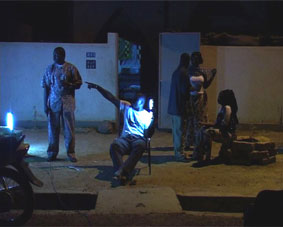
Neil Beloufa
Kempinski
Experimental video | dv | color | 15:0 | France, Mali | 2007
Welcome to Kempinski, The people of this mystical and animist place introduce it to us. "Today we have a space station. We will soon launch space ships and a few satellites that will allow us to have much more informations about the other stations and other stars. " The video has no script and the screenplay is caused by a specific game rule.
Neil Beloufa was born on 1985 in Paris. He is student in the Beaux-Arts and in the Art Decoratifs of Paris. He is in scholar exchange in Cooper Union in New York. In 2008 he ll be in CalArts in Los Angeles.
Louidgi Beltrame
Catalogue : 2018El Brujo | Experimental film | 4k | color | 17:29 | France, Peru | 2016
Louidgi Beltrame
El Brujo
Experimental film | 4k | color | 17:29 | France, Peru | 2016
El Brujo, which means "The Sorcerer" in Spanish, is also the name of a Mochica archeological site. It is on this Peruvian beach that Louidgi Beltrame shot a part of his movie. The curandero (shaman) José Levis Picón Saguma is performing a re-enactment of François Truffaut’s 400 blows (1959) last sequence. In that sequence, the young hero, Antoine Doinel, interpreted at the time by iconic ?nouvelle-vague? actor Jean-Pierre Léaud, is running away in direction of the ocean. Right performing a Mesa - a psycho-active San-Pedro cactus related traditional healing ceremony - José Levis Picón Saguma is taking care of the vacant space left into the cinematographic apparatus by the actor whom was sick at the time of the shooting and thus was forced to remain in France. Feeling better soon after this magical operation, Jean-Pierre Léaud has been shot drifting through the streets of Paris, following a trajectory which is superimposing his memories from the 400 blows original shooting with his own "Nouvelle-Vague" subjective history. Through these transpositions, Beltrame orchestrates a series of shifts, with a migration of characters, patterns and eras. The geometric lines of the pyramids and excavations of the Peruvian landscape are echoed in the structure of the film?s editing, with tracking and panoramic shots, and are highlighted by the synthetic modular music of the track Triangle (1979) by Jacno.
Louidgi Beltrame was born in 1971 in Marseille and now lives in Paris. He studied at the Ecole supérieur d’art et de design Marseille-Mediterranée, the Fresnoy - Studio national des arts contemporains, and la Villa Arson in Nice. Beltrame is a growing artist in the contemporary art scene and has won the SAM prize for contemporary art in 2014. His work is based on documenting modes of human organization throughout the history of the 20th century. He travels to sites defined by a paradigmatic relation to modernity: Hiroshima, Rio de Janeiro, Brasilia, Chandigarh, Tchernobyl or the mining colony of Gunkanjima, over the sea off Nagasaki. His films - based on the recording of reality and the constitution of an archive - appeal to fiction as a possible way to consider History. The artist has exhibited in many places, namely at the Palais de tokyo (2006/2016), the Centre d’Art Contemporain de Chelles (2010), The Musée d’Art moderne et contemporain, Strasbourg (2008), the Pinchuk Art Center, Kiev (2007), l’Atelier de Jeu de Paume, Paris (2006), the Musée d’art conemporain de Val-de-Marne, France (2005), the Centre Georges Pompidou, Paris (2005).
Catalogue : 2015the walking tree | Experimental doc. | 16mm | color | 35:0 | France | 2014
Louidgi Beltrame
the walking tree
Experimental doc. | 16mm | color | 35:0 | France | 2014
Louidgi Beltrame films in 16 mm a large banyan tree in the botanical gardens in Calcutta. This tree, whose distinctive feature is the way it spreads rhizome-like over several hundred yards, is approached like a forest of clones, a metaphysical space where histories re-surface: the history of the invention and parallel development of photography and telegraphy in the context of colonized India, Linnaeus’ dream according to Foucault, reminiscences of the films of Ritwik Ghatak and Satyajit Ray, where reality and fiction met.
Catalogue : 2011gunkanjima | Experimental doc. | dv | color | 33:0 | France | 2010
Louidgi Beltrame
gunkanjima
Experimental doc. | dv | color | 33:0 | France | 2010
Située au large de Nagasaki au Japon, l?île de Gunkanjima est une colonie minière abandonnée depuis 1974. Objet d?une expérimentation urbaine verticale, extrême, et non planifiée, l?île rassemble aujourd?hui les vestiges archéologiques de l?architecture moderne japonaise. Ces formes vides, filmées comme des sculptures monumentales, sont néanmoins habitées par des histoires stratifiées - celles des conditions de production, des idéologies qui ont motivé ces chantiers et des hommes qui les ont bâti et exploités.
Louidgi Beltrame est un artiste français. Né à Marseille, il vit et travaille actuellement à Paris. Son travail se développe autour de la déconstruction des structures narratives et formelles du cinéma, considéré comme un médium avec sa syntaxe spécifique, mais également comme une force politique qui a influencé les développements du siècle passé, et qui constitue également une documentation de l?architecture moderniste et de ses vestiges. Le travail de Louidgi Beltrame est exposé dans des galeries, des musées et présenté dans des festivals de cinéma en France et à l?étranger, notamment au Musée d?Art Moderne et Contemporain de Strasbourg ; à Paris au Musée du Jeu de Paume, à la Fondation Ricard, au Palais de Tokyo, au centre d?art Le Plateau, au Centre Georges Pompidou. Ses films ont été diffusés au FID Marseille (festival international du documentaire), au festival international du film de Rotterdam, au festival du film de Locarno, à la Fondation Funarte de Rio de Janeiro, à LOOP, Barcelone ; au Japon à la Echigo Tsumari Art Triennal, à Niagata et à l?Hiroshima Art Document.
Catalogue : 2009Brasilia/Chandigarh | Experimental doc. | dv | color | 27:0 | France | 2008
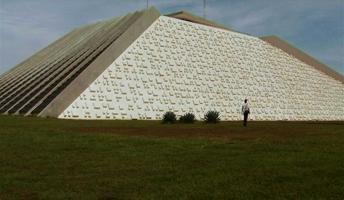
Louidgi Beltrame
Brasilia/Chandigarh
Experimental doc. | dv | color | 27:0 | France | 2008
Two architects hoped to build the ideal city: Oscar Niemeyer created Brasilia in the middle of the Brazilian mato (savanna); Corbusier went to India to build Chandigarh. Both cities raise above the landscape, like two futuristic memoranda of concrete, monuments to their builders, those rare inhabitants who are given to us. The film is bases on the respective geometrics of Brasilia and Chandigarh, while the dialogue takes place between the two cities.
Louidgi Beltrame, screen writer and artist, was born in Marseille in 1971. He presented his work at the Workshop of the Play of Palm, the Palais de Tokyo and the Museum Andre Malraux in Le Havre as well as the Festival of Film of Locarno and the International Documentary Festival of Marseille.
Yosr Ben Messaoud
Catalogue : 2026Envol | Video | hdv | color | 4:12 | Tunisia, France | 2024
Yosr Ben Messaoud
Envol
Video | hdv | color | 4:12 | Tunisia, France | 2024
In the dim light, the hand emerges like a fragment of presence, suspended between appearance and disappearance. It becomes a sensitive territory, brushed by a silent intimacy, unfolding like an open landscape, a place that welcomes what passes through without ever fully allowing itself to be grasped. The video then becomes a space of slowing down, where the gaze encounters a partial yet inhabited presence, crossed by a world in motion.
Yosr Ben Messaoud is a visual artist working between France and Tunisia. She is currently studying at the École des Beaux-Arts de Paris, after completing a degree in contemporary art and the humanities at the University of Vincennes. Her work includes video, photography, drawing, and installations, as well as hybrid forms that move between these different modes of expression. The variety of operative forms conveys an aesthetics of openness and suspension, where one is called upon to become a bridge, to welcome alterity in order to allow a new form of communion to emerge. In her practice, she examines questions related to the displacement of narratives and their survival, beginning from the intimate, through the creation of dispositifs conceived both as systems of reception, containers of experience, and circuits of narration—structures that become inhabited by what surrounds them. The axes shift incessantly between lived experience and affective facts, collected images and those that persist, the intimate and the collective voice, in order to reflect on the human condition—understood not as humanity at the centre of the world, but as part of its sensitive order, material, and social
Haim Ben Shitrit
Catalogue : 2007No Johny no | Experimental video | dv | color and b&w | 3:36 | Israel | 2006
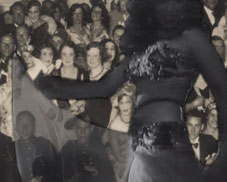
Haim Ben Shitrit
No Johny no
Experimental video | dv | color and b&w | 3:36 | Israel | 2006
"Anonymous soldiers", the anthem of the "Shtern gang", an anti- British extreme Jewish Underground which operated in the forties, translated to French with spelling mistakes. The text is being recited by a man and a woman, the father and mother of the artist, who are not familiar with the text and who are trying to please their son who has come for a visit. The recitation is interrupted by their corrections of the spelling, by the mother insisting on giving her son something to eat, and other sounds and oriental rhythms. The sound is orchestrated to characters camouflaged by desert landscapes digitally sculpted onto their faces. "no johny no" is a virtual belly dance, with a dreamy French-Arab, for English soldiers from a family photo album.
Born in Jerusalem, Haim Ben Shitrit studied with Christian Boltonsky at the Academy of Fine Arts in Paris. He graduated with distinction from the Bezalel Academy of Art and Design in Jerusalem. Over the years he has been awarded grants from the Manet-Katz Foundation, America-Israel Fund, and the Pollock-Krasner Foundation New York. His video installations and projects have been exhibited in Israel, France, England, Belgium, and Canada. Ben Shitrit is currently the director of the art department at the Israel Arts and Science Academy in Jerusalem.
Younes Ben Slimane
Catalogue : 2026Images De Tunisie | Experimental doc. | 0 | color and b&w | 14:39 | Tunisia | 2025

Younes Ben Slimane
Images De Tunisie
Experimental doc. | 0 | color and b&w | 14:39 | Tunisia | 2025
Images de Tunisie reclaims and recontextualizes archival footage from 1940s newsreels produced by Les Actualités Françaises, combining it with new images filmed at the same sites, among the architectures that still remain.
Younès Ben Slimane is a Tunisian visual artist and filmmaker. He graduated in architecture from the National School of Architecture and Urbanism in Tunis before completing postgraduate studies at Le Fresnoy – Studio National des Arts Contemporains (FR). His work has been showcased at the Mucem in Marseille (FR), the Biennale de l’Art Africain Contemporain in Dakar (SN), the Museum of Contemporary Art in Skopje (MK), the Institut du Monde Arabe in Paris (FR), the Beirut Art Center (LB), ETH Zurich – gta exhibitions in Zurich (CH), the Versailles Architecture Biennale in Versailles (FR), the Art Explora Museum Boat, and the Wexner Center for the Arts in Ohio (US), the Zaha Hadid Foundation in London (UK) and the Galeria de Arte Cinemática in Vila do Conde (PT). His films have been selected for international festivals including the Locarno Film Festival (CH),CPH:DOX (DK), Black Star Film Festival (US), DokuFest (XK), EXiS Seoul, (KR) and Prismatic Ground New York (US), among others. He has received numerous awards, including Loop Barcelona Award (2022, ES). His work is part of art collections, including the Museum of Contemporary Art of Barcelona (MACBA) Print and Kadist Paris–San Francisco.
Younès Ben Slimane
Catalogue : 2023We Knew How Beautiful They Were, These Islands | Experimental doc. | hdcam | color | 20:0 | Tunisia, France | 2022
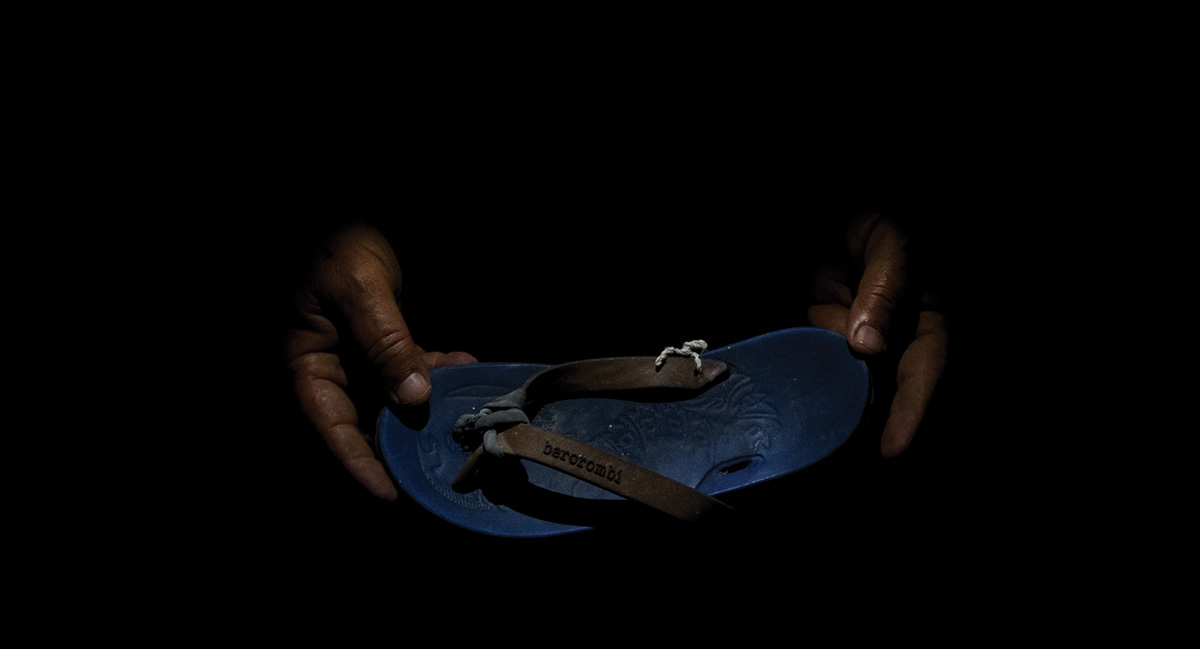
Younès Ben Slimane
We Knew How Beautiful They Were, These Islands
Experimental doc. | hdcam | color | 20:0 | Tunisia, France | 2022
A lone figure digs a grave in the dead of night. With no dialogue – and no sound other than the wind, the crackling of a fire and the scrape of a shovel against dry earth – we are confronted with a dark and mysterious, possibly cursed, universe where every object seems haunted by a meaning we barely sense, but which seem to confirm our anxieties. The head of an old doll, a comb, a lipstick. Relics whose silent language speaks of the end of their former owners. At sea, in the desert. Younes Ben Slimane’s disturbingly beautiful and melancholic imagery is bathed in darkness and in a golden chiaroscuro, lit only by the stars and the lone grave diggers’ headlamps.
Younes Ben Slimane: Tunisian artist and filmmaker, graduated from Le Fresnoy - Studio national des arts contemporains in 2022. His films have been selected in international festivals such as Locarno Film Festival, CPH:DOX, DokuFest, Festival dei Popoli. His work is part of the collections of art institutions and museums including the Institute of Contemporary Art, Villeurbanne/Rhône-Alpes (IAC), France and the Museum of Contemporary Art of Barcelona, MACBA - Barcelona, Spain.
Samy Benammar, Mohamad Awad
Catalogue : 2026Adieu Ugarit | Documentary | 16mm | black and white | 15:45 | Canada | 2024
Samy Benammar, Mohamad Awad
Adieu Ugarit
Documentary | 16mm | black and white | 15:45 | Canada | 2024
In 2012, Mohamed had seen his best friend shot dead by an armed militia on the outskirts of Damascus, Syria; the blood spilled in the lake contaminated his memory. Ten years on, the reflections on the Laurentian waters revive Mohamed's trauma. I ask him if he'd like to dredge up the memories, repair the pain by retreating for a few days to the most distressing calm he can find. He talks about death, immigration and anger. We wonder how and why we should recount this story.
Samy Benammar is a filmmaker, photographer, and art critic based between Montreal and Marseille. Drawing from his Algerian roots and working-class upbringing, his work blends a reflective documentary approach with tactile experimentation. He seeks a form of visual reconciliation while underscoring the irreparable fractures left by fantasies of the past. Often hovering on the edge of disappearance, his images explore the tension between physical and imagined space, between memory, identity, and stone. He has served on the editorial boards of Hors Champ, 24 images, and Panorama-cinéma, and is currently pursuing a PhD on colonial photography in the Aurès region of Algeria.